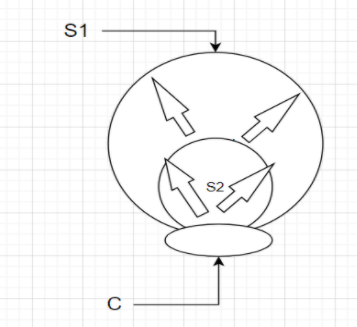
Consider two surfaces $S_1$ and $S_2$ sharing the same open circular boundary as shown in the figure. If \[{{{\theta }}_{{S_1}}}\] and \[{{{\theta }}_{{S_2}}}\]are magnetic flux through these surfaces then,

(A) \[{{{\theta }}_{{S_1}}} > {{{\theta }}_{{S_2}}}\]
(B) \[{{{\theta }}_{{S_2}}} > {{{\theta }}_{{S_1}}}\]
(C) \[{{{\theta }}_{{S_2}}} = {{{\theta }}_{{S_1}}}\]
(D) \[{{{\theta }}_{{S_1}}} = {{{\theta }}_{{S_2}}}\]

Answer
537.9k+ views
Hint: Magnetic flux is the number of the magnetic field passing through a closed surface. The measurement of the magnetic field actually provides the total magnetic field that passes through a given surface area.
Complete step by step answer:

Case 1:
Since nothing is mentioned about the presence of any magnetic field producing element inside the surfaces, even if we consider C to be a closed boundary we know that that \[\phi = \oint {\overrightarrow {B.} } \overrightarrow {dS} \] but without the presence of any magnetic field producing element within the closed surface we get $\overrightarrow B = 0$ and hence the value of flux = 0
\[{{{\theta }}_{{S_1}}} = {{{\theta }}_{{S_2}}} = 0\]
Case 2:
Now we consider that some flux is entering through the opening which is being shared by both the surfaces $S_1$ and $S_2$ we can notice that,
The flux that is passing through C and going through surface $S_2$ will also pass through surface $S_1$ so the flux passing through both surfaces is the same and equals net flux entering through their common circular boundary.
If we start from calculating the flux coming to $S_1$ then also we can notice that whatever the amount of flux is coming to $S_1$ that flux has come from nowhere else but the surface $S_2$. So by this approach also we can conclude that net flux passing through both the surfaces will be equal.
\[{{{\theta }}_{{S_1}}} = {{{\theta }}_{{S_2}}} = 0\]
Hence, the correct answer is option (D).
Note: In order to tackle such kinds of questions one should have understanding knowledge of the various terms involved and the application of Gauss's law. Students should have to practice a lot of numerical problems based on the application of Gauss law to master the concept behind the problems.
Complete step by step answer:

Case 1:
Since nothing is mentioned about the presence of any magnetic field producing element inside the surfaces, even if we consider C to be a closed boundary we know that that \[\phi = \oint {\overrightarrow {B.} } \overrightarrow {dS} \] but without the presence of any magnetic field producing element within the closed surface we get $\overrightarrow B = 0$ and hence the value of flux = 0
\[{{{\theta }}_{{S_1}}} = {{{\theta }}_{{S_2}}} = 0\]
Case 2:
Now we consider that some flux is entering through the opening which is being shared by both the surfaces $S_1$ and $S_2$ we can notice that,
The flux that is passing through C and going through surface $S_2$ will also pass through surface $S_1$ so the flux passing through both surfaces is the same and equals net flux entering through their common circular boundary.
If we start from calculating the flux coming to $S_1$ then also we can notice that whatever the amount of flux is coming to $S_1$ that flux has come from nowhere else but the surface $S_2$. So by this approach also we can conclude that net flux passing through both the surfaces will be equal.
\[{{{\theta }}_{{S_1}}} = {{{\theta }}_{{S_2}}} = 0\]
Hence, the correct answer is option (D).
Note: In order to tackle such kinds of questions one should have understanding knowledge of the various terms involved and the application of Gauss's law. Students should have to practice a lot of numerical problems based on the application of Gauss law to master the concept behind the problems.
Recently Updated Pages
Master Class 12 Economics: Engaging Questions & Answers for Success

Master Class 12 Maths: Engaging Questions & Answers for Success

Master Class 12 Biology: Engaging Questions & Answers for Success

Master Class 12 Physics: Engaging Questions & Answers for Success

Master Class 8 Maths: Engaging Questions & Answers for Success

Class 8 Question and Answer - Your Ultimate Solutions Guide

Trending doubts
Which animal has three hearts class 11 biology CBSE

1 Quintal is equal to a 110 kg b 10 kg c 100kg d 1000 class 11 physics CBSE

Explain zero factorial class 11 maths CBSE

Mention the basic forces in nature class 11 physics CBSE

What is centripetal acceleration Derive the expression class 11 physics CBSE

Bond order ofO2 O2+ O2 and O22 is in order A O2 langle class 11 chemistry CBSE




